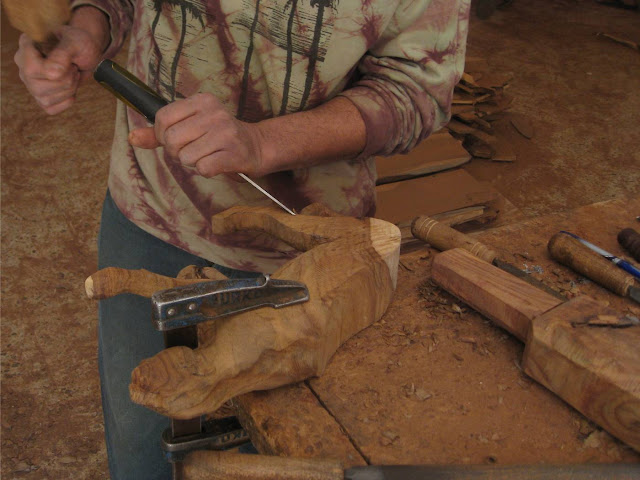To ease Adel's concern, we telephoned a number that I had found on the Internet. Good fortune put us in contact with a carpenter named Ashraf, who met us somewhere in the sprawl of Hagaza village, located some 25 km North of Luxor. Its intricate network of dirt roads is lined with the homes of 60,000 people.
Ashraf took us to his two-room home. Here, in the back room with the family kitchen, he stains products made in the workshop that I was seeking. A computer with a database of product images has pride of place in the 2 m X 1.5 m front room. Wide benches on either side of this room serve multiple purposes: sofas for guests, beds for sleeping, and product display for surprise visitors.
Egyptian hospitality necessitates a glass of tea, which I sip while discussing all the products available for purchase. Ashraf brings out from the back room a beautiful slated-back arm chair that he has stained. Regretfully, LE500 is more money than I have to spend on this trip. When I ask the price of a wooden salad bowl, he pulls out a measuring tape to determine the size of the block of wood it was carved from.
With purchases in hand, Ashraf guides us the 3 km length of the village to our goal, the Hagaza Woodwork Vocational Training Center. Success!
For some 25 years, the center has been training the unemployed young men of the village in woodworking skills in order to alleviate poverty. Ashraf graduated from the program 15 years ago and has been able to provide for his family ever since. Life isn't easy but, thanks to his training and product marketing conducted in Cairo, it isn't dire.
Fifteen young men each year enroll in the three-year training program operated by an Egyptian non-governmental agency called the Association of Upper Egypt for Education and Development. None of the students were in attendance on this particular Tuesday because the national government closed all schools when the revolution began and has yet to re-open all of the universities and trade schools South of Cairo out of "security concerns".
Another unfortunate consequence of recent political developments was the cancellation of the annual exhibition in Cairo where many of Hegaza's small wood-carved objects are sold. It is the sales at this exhibition and through the Fair Trade Egypt shop that the craftsmen depend for their livelihood. And it is through these marketing efforts that Hagaza woodwork has become well-known, if not famous.
Hagaza's exhibition room presents a wide variety of products for sale. Pharaonic designs inspire many of the products, particularly the elegant nut trays that recall stone make-up tablets on display in the Louvre and Cairo's Egyptian Museum. But individual artistic imaginations obviously have scope here too as I spy a couple of Hagaza Godzillas on the top shelf.
Each nut tray represents about six hours of work, while a sculpted panther takes about two days. Mostly, the men carve wood from the "Sersau" (Dalbergia sissoo) tree, which the Centre brings from Aswan. Generations ago, the British imported the tree from India and it seems to flourish in southern Egypt, which is surprising given the climatic differences. Local tamaris (Tamarix aphylla), a blond wood, and Nile acacia (Acacia nilotica) are other popular woods that are carved.
From these woods the men trained at the Centre are carving out a better life for themselves and their families. Many, like Ashraf, now work independently. The Hagaza Centre shows how a relatively small investment made to increase human skills and to create links to external markets makes a big difference to people living in little corners of the world, and maybe even makes them famous.
WHERE TO FIND ME
View Larger Map
This building, located on the edge of the desert, houses the woodworking training facility.
| GETTING THERE | USEFUL INFO SOURCES |
|---|---|
| Because the Hagaza Woodwork Vocational Training Centre is located at the south end of the village of Hagaza, it is easiest to approach it from the village of Khuzam to the South. Beginning from the Luxor Airport checkpoint, drive North on the Luxor-Qena highway for 16.8 km. You will pass a major checkpoint at Ashi. The next major checkpoint is located at the village of Khusam. Immediately after passing through the maze of road barriers, turn right (East) and follow this road for 4.3 km. You will drive beside an irrigation canal rich with bird life. Now the route gets tricky. After 4.3km, turn right (East) on a narrow road. Follow this road and turn left (North) at the first intersection. Travel North for about 1 km and turn right (East), heading out into the desert. You will see the high walls of the Centre on the right. | Association of Upper Egypt for Education and Development website: Hagaza Vocational Training Centre |
| Fair Trade Egypt website: Hegaza Wooden Craft Project and Product Sales | |
| Ashraf of Hagaza contact number: 012-140-6920 |












1 comment:
hi
i just want to ask a question did they talk with u in hegaza qus about the priest who teach them the woood art
did u visit his house ??????
did u visit his tomb ???
ur reply will be very appreciated
m mail is
magued_eg@yahoo.com
thanks
Post a Comment